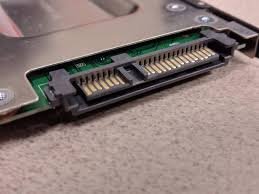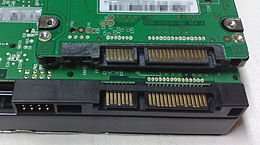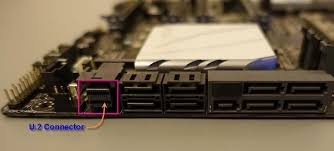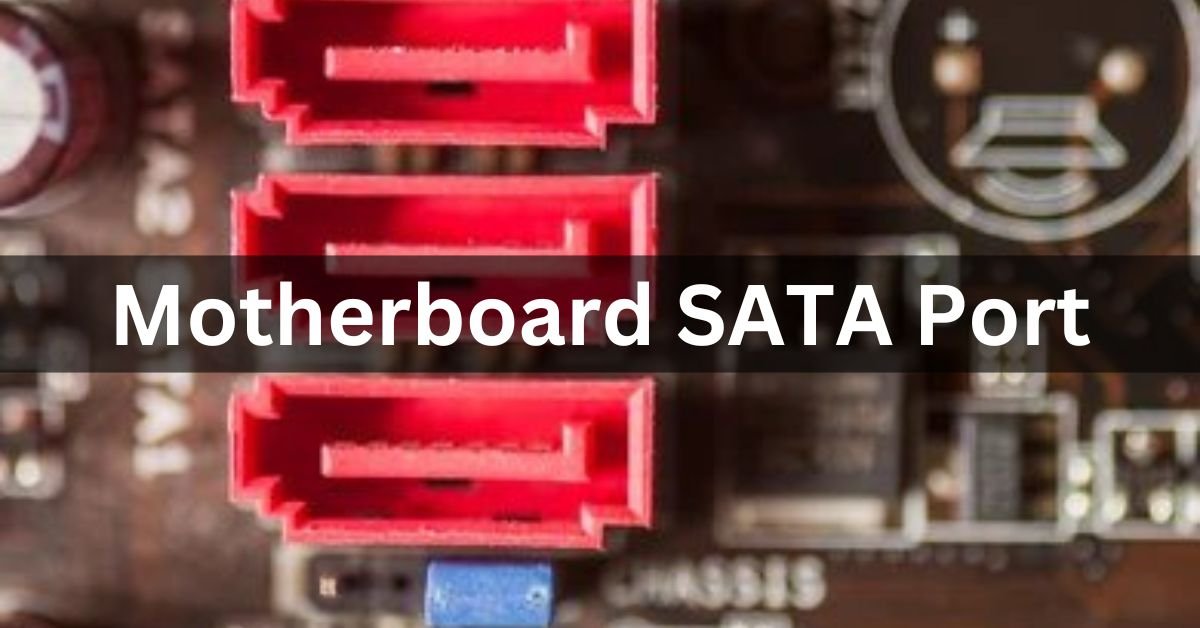When it comes to building or upgrading your computer, understanding the motherboard and its components is crucial. One of the essential features of a motherboard is its SATA ports. These small but mighty connectors are vital for linking your storage devices and ensuring your system runs smoothly.
A motherboard SATA port is a connector on the computer’s main board. It links hard drives or SSDs to the system, allowing data to be transferred between the storage device and the computer.
In this article, we will discuss “Motherboard SATA Port”.
What is a SATA Port?
1. Definition and Function:
SATA, which stands for Serial ATA (Serial Advanced Technology Attachment), is an interface used to connect storage devices like hard drives, SSDs, and optical drives to the motherboard. The SATA port allows for the transfer of data between these devices and the computer’s main system.
2. Historical Context:
Introduced in 2003, SATA replaced the older Parallel ATA (PATA) standard, bringing faster data transfer speeds and more efficient power usage. Over the years, SATA has evolved, with newer versions offering even greater performance enhancements.
Types of SATA Ports:
1. SATA I:
The first generation of SATA, known as SATA I, provides data transfer speeds of up to 1.5 Gb/s. While this might seem slow by today’s standards, it was a significant improvement over PATA at the time.
2. SATA II:
SATA II, or SATA 3Gb/s, doubled the data transfer rate to 3 Gb/s. This version introduced features like Native Command Queuing (NCQ), which improves the performance of SSDs and multi-tasking environments.
3. SATA III:
The latest and most common version, SATA III, offers data transfer speeds of up to 6 Gb/s. It is fully backward compatible with SATA I and II, making it a versatile choice for modern computers.
How SATA Ports Work?

1. Data Transfer Process:
SATA ports work by establishing a serial connection between the motherboard and the storage device. This connection allows for high-speed data transfer, enabling quick read and write operations on your hard drives or SSDs.
2. Connecting Components:
To use a SATA port, you simply connect one end of a SATA cable to the port on the motherboard and the other end to the corresponding port on the storage device. This setup ensures a stable and efficient link between the two components.
Benefits of Using SATA Ports:
1. Speed:
One of the main advantages of SATA ports is their speed. With data transfer rates of up to 6 Gb/s, SATA III ports allow for rapid access to your files and programs.
2. Compatibility:
SATA ports are widely compatible with a range of storage devices, from traditional hard drives to modern SSDs. This flexibility makes them a popular choice for both new builds and upgrades.
3. Reliability:
SATA connections are known for their reliability and stability. They provide a secure and consistent link between your storage devices and the motherboard, minimizing the risk of data loss or corruption.
Common Devices Using SATA Ports:
1. Hard Disk Drives (HDDs):
HDDs are one of the most common devices that use SATA ports. These drives offer large storage capacities at relatively low costs, making them ideal for bulk data storage.
2. Solid State Drives (SSDs):
SSDs, which use flash memory to store data, also connect via SATA ports. They are much faster than HDDs, providing quick boot times and fast access to applications and files.
3. Optical Drives:
Optical drives, like DVD and Blu-ray players, also utilize SATA ports. While these devices are less common in modern builds, they still rely on SATA for data transfer.
SATA vs Other Interfaces:
1. SATA vs IDE:
Before SATA, the standard interface for connecting storage devices was IDE (Integrated Drive Electronics). SATA offers significant improvements over IDE, including faster data transfer rates, more straightforward cabling, and better overall performance.
2. SATA vs NVMe:
NVMe (Non-Volatile Memory Express) is a newer interface designed specifically for SSDs, offering even faster speeds than SATA. However, SATA remains popular due to its widespread compatibility and lower cost.
Does It Matter What SATA Ports You Use?
Yes, it matters which SATA ports you use. Some ports may be faster, and using specific ports can improve the speed and performance of your hard drives or SSDs. Check your motherboard manual for the best options.
What are SATA ports on a motherboard for?
SATA ports on a motherboard connect hard drives and SSDs to the computer. They allow data to move between storage devices and the computer, enabling the system to read and write information on these drives.
Which SATA Port Is the Fastest?
The fastest SATA ports are usually the ones labeled SATA 3 or SATA III. These ports offer the highest data transfer speeds. Check your motherboard manual to find which ports are SATA 3 for the best performance.
Do I Need to Plug SATA Devices in Order?
No, you don’t need to plug SATA devices in order. However, it can help with organization and troubleshooting. The operating system may list them differently, but they will still work regardless of the order they’re connected.
Does Changing the SATA Port Matter?
Yes, changing the SATA port can matter. Some ports are faster (like SATA 3), and using different ports can affect your device’s performance. Also, your system might need reconfiguration if you change the port of a boot drive.
What do the different colours of the SATA ports on my motherboard mean?
The different colors of SATA ports on your motherboard help identify their types and speeds. For example, SATA 3 ports might be one color, while SATA 2 ports are another. Check your motherboard manual to understand each color’s meaning.
What’s the Difference Between SATA 1, 2, and 3?
The difference between SATA 1, 2, and 3 is their speed. SATA 1 has a speed of 1.5 Gbps, SATA 2 has 3 Gbps, and SATA 3 has 6 Gbps. Higher numbers mean faster data transfer, which improves overall performance for storage devices.
What SATA port to connect HDD to on my MoBo?
Connect your HDD to a SATA port on your motherboard. Look for ports labeled “SATA 3” for the fastest speeds. Consult your motherboard manual to identify these ports. Ensure the HDD is securely plugged in and use the appropriate SATA cable.
Which SATA Port Should I Use for an SSD?
For an SSD, it’s best to use a SATA 3 port on your motherboard. These ports offer the highest speed, maximizing the performance of your SSD. Check your motherboard manual to identify the SATA 3 ports, and use a compatible SATA cable to connect the SSD securely.
Is SATA Backwards Compatible?
Yes, SATA is backward compatible. This means newer SATA devices (like SATA 3 SSDs) can be used with older SATA ports (like SATA 2) but will operate at the speed of the slower port. Older SATA devices can also be used with newer SATA ports.
Are All SATA Connectors the Same?
No, not all SATA connectors are the same. While they have the same basic shape and function, there are different versions such as SATA 1, SATA 2, and SATA 3, which offer varying speeds.
Additionally, some connectors may have different features or configurations depending on the manufacturer.
What are the Different Versions of SATA?
There are three main versions of SATA: SATA 1, SATA 2, and SATA 3. SATA 1 has a speed of 1.5 Gbps, SATA 2 has 3 Gbps, and SATA 3 has 6 Gbps.

Each version offers progressively faster data transfer rates, improving the performance of storage devices like hard drives and SSDs.
What is a SATA Slot on Motherboard?
A SATA slot on a motherboard is a connector where you plug in SATA devices like hard drives or SSDs.
It allows these devices to communicate with the computer, enabling data transfer for storage and retrieval. Modern motherboards typically have multiple SATA slots for connecting multiple storage devices.
What Can You Connect to the SATA Port on a Motherboard?
You can connect various storage devices to the SATA port on a motherboard, including hard disk drives (HDDs), solid-state drives (SSDs), optical drives (like DVD or Blu-ray drives), and some other peripherals like external hard drives or SATA-based expansion cards.
Read: Do All CPU Coolers Fit All Motherboards – The Guide of 2024!
How to Identify SATA Connector on Motherboard?
To identify a SATA connector on a motherboard, look for rectangular-shaped ports usually grouped. They are typically labeled “SATA” on the motherboard itself.
Additionally, SATA ports often have a small L-shaped notch on one side, which matches the corresponding notch on SATA cables for proper alignment.
Can We Use Any SATA Connector on the Motherboard?
Yes, you can use any available SATA connector on the motherboard to connect SATA devices like hard drives or SSDs. However, it’s advisable to use the fastest available SATA port, usually labeled as SATA 3, for optimal performance, especially with modern SSDs.
Is SATA a Dead Platform?
No, SATA is not a dead platform. While newer storage technologies like NVMe are gaining popularity for their faster speeds, SATA is still widely used and supported in computers and motherboards. It remains a reliable and affordable option for connecting storage devices.
What is the use of a SATA connector in a motherboard?
A SATA connector on a motherboard is used to connect storage devices like hard drives and SSDs to the computer. It enables data transfer between the storage device and the motherboard, allowing the system to access and store files and data.
Where to plug SATA into motherboard?
To plug SATA devices into the motherboard, locate the SATA ports on the motherboard. These are usually rectangular-shaped connectors grouped.
Align the SATA cable’s L-shaped notch with the corresponding notch on the port, then gently push the cable into the port until it clicks into place.
Are all SATA ports the same?
No, not all SATA ports are the same. While they serve the same purpose of connecting storage devices to the motherboard, different SATA ports may have varying speeds or features. For example, SATA 3 ports offer faster data transfer rates compared to SATA 2 or SATA 1 ports.
SATA Port SSD?
A SATA port SSD is a solid-state drive that connects to a computer’s motherboard using a SATA port. It offers faster performance and reliability compared to traditional hard disk drives.
SATA port SSDs are commonly used to improve the speed and responsiveness of computers and laptops.
Motherboard Sata Cable?
A motherboard SATA cable is a data cable used to connect storage devices like hard drives or SSDs to the motherboard’s SATA ports.
It facilitates communication between the storage device and the motherboard, allowing data to be transferred between them for storage or retrieval purposes.
Motherboard Sata Port USB C?
A motherboard usually has SATA ports for connecting storage drives and USB-C ports for fast data transfer.
SATA ports connect to hard drives or SSDs, while USB-C ports connect to devices like smartphones and external drives. Both are important for different functions on your computer.
Motherboard Sata Port USB?
A motherboard has SATA ports and USB ports. SATA ports connect to storage drives like hard drives and SSDs.
USB ports connect to devices like keyboards, mice, and flash drives. Both are essential for connecting different parts and devices to your computer.
How To Check Sata Ports On Motherboard?
To check SATA ports on a motherboard, open your computer case and look for small, usually black or blue, connectors labeled “SATA.”
You can also check the motherboard’s manual or look up the motherboard model online to find the SATA port locations.
Where can I find the SATA ports on the motherboard?

You can find SATA ports on the motherboard by opening your computer case. Look for small, usually black or blue, connectors labeled “SATA” near the edge of the board. They are often grouped together and connected to storage drives like hard drives and SSDs.
FAQs:
1. Are SATA cables included with the motherboard or the drives?
Yes, SATA cables are usually included with the motherboard, not the drives. Some drives might include them, but it’s more common with motherboards.
2. Are all SATA ports on a motherboard the same?
No, not all SATA ports on a motherboard are the same. Some may support faster speeds (like SATA 3), while others might be slower (like SATA 2).
3. How do I know what SATA port is on my motherboard?
To know what SATA port is on your motherboard, check the motherboard manual or look for labels on the motherboard itself. You can also find this information on the manufacturer’s website.
4. What is the purpose of the white port on a motherboard?
The white port on a motherboard is usually a PCI or PCIe slot. It is used to connect expansion cards like graphics cards, sound cards, or network cards to your computer.
5. What is the purpose of multiple SATA ports on the motherboard?
The purpose of multiple SATA ports on the motherboard is to connect several storage devices like hard drives and SSDs, allowing you to expand your computer’s storage capacity and use multiple drives.
6. Where is the “SATA controller” on a motherboard?
The SATA controller on a motherboard is integrated into the chipset, usually located near the CPU. It manages the SATA ports, allowing them to connect to storage devices like hard drives and SSDs.
7. Where is the SATA cable connector in a motherboard?
The SATA cable connector on a motherboard is typically found near the edge of the board. It looks like a small, rectangular socket with several pins inside for connecting SATA cables from storage drives like hard drives or SSDs.
8. What is a SATA controller?
A SATA controller is a component on the motherboard responsible for managing SATA ports. It facilitates communication between the motherboard and SATA devices like hard drives and SSDs, enabling data transfer and storage operations.
9. How do you connect two SATA hard drives to a motherboard?
To connect two SATA hard drives to a motherboard, use two SATA data cables to connect each drive to separate SATA ports on the motherboard. Then, use a SATA power cable from the power supply to each drive.
10. Can you recommend a motherboard which has 10 SATA ports?
No, I cannot recommend a specific motherboard. However, you can search online for motherboards with 10 SATA ports or consult with computer hardware retailers for available options.
Conclusion:
In conclusion, SATA ports on a motherboard are crucial for connecting storage devices like hard drives and SSDs to your computer. They enable fast data transfer, offer compatibility with various devices, and ensure reliable performance. Understanding the types of SATA ports and their functionalities helps users optimize their system’s storage capabilities for efficient computing.
